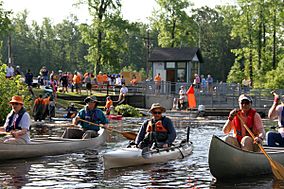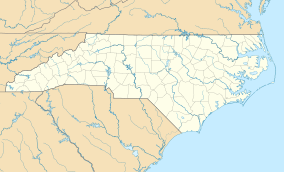Dismal Swamp State Park facts for kids
Quick facts for kids Dismal Swamp State Park |
|
|---|---|
|
IUCN Category III (Natural Monument)
|
|

State park entrance bridge on the Dismal Swamp Canal.
|
|
| Location | Camden, North Carolina, United States |
| Area | 14,432 acres (58.40 km2) |
| Elevation | 16 ft (4.9 m) |
| Established | 1974 |
| Named for | Great Dismal Swamp |
| Operator | North Carolina Division of Parks and Recreation |
| Website | Dismal Swamp State Park |
Dismal Swamp State Park is a special park in Camden County, North Carolina, in the United States. It's part of the much larger Great Dismal Swamp. The park was first set up in 1974 as a "state natural area." This happened with help from a group called The Nature Conservancy.
Then, on July 28, 2007, the North Carolina government officially made it a state park. It opened its doors to visitors in 2008. This was a big deal because it was the first time people could easily visit the Great Dismal Swamp in North Carolina. The park is a huge protected area, covering over 14,000 acres (about 58 square kilometers). It sits right on the border between North Carolina and Virginia. The park office is about 3 miles (5 km) south of the border, near South Mills, on U.S. Route 17. You can explore the park on hiking and biking trails. The Dismal Swamp Canal is also popular with boaters who use the Intracoastal Waterway.
Contents
History of Dismal Swamp State Park
Early Explorers and Settlers
Long ago, by the 1650s, not many Native Americans lived in the Great Dismal Swamp area. European settlers didn't pay much attention to it at first. In 1665, William Drummond, who later became a governor of North Carolina, was the first European to explore the lake now named after him.
In 1728, William Byrd II led a team to map out the border between Virginia and North Carolina right through the swamp. Later, George Washington visited the swamp and called it a "glorious paradise." He was so impressed that he started the Dismal Swamp Land Company in 1763. This company worked to drain parts of the swamp and harvest its valuable timber. A five-mile (8 km) ditch on the west side of the park still carries his name today. By 1805, the Dismal Swamp Canal began operating. It was like a busy highway for timber being moved out of the swamp.
A Place of Refuge
Before and during the American Civil War, the Great Dismal Swamp became a secret hiding place. Many people who had escaped slavery found safety deep within the swamp. Recent studies show that thousands of these "maroons" lived in the swamp between the 1600s and 1865. The famous author Harriet Beecher Stowe wrote a book called Dred: A Tale of the Great Dismal Swamp which was inspired by their stories.
Changes to the Swamp Over Time
Even though people tried to drain the swamp, it never fully worked. However, cutting down trees (logging) was a very successful business. Logging continued in the swamp until as late as 1976. Almost the entire swamp has been logged at least once. Many areas have also been affected by natural wildfires over the years.
Over time, farming, businesses, and homes were built, destroying much of the original swamp. What's left today is less than half of its original size. Before the park was created, over 140 miles (225 km) of roads were built to help loggers reach the timber. These roads changed how water flowed in the swamp. The ditches dug for the roads drained water away, making some areas drier. The roads also blocked water from flowing across the swamp's surface, causing some parts to flood with stagnant water.
Logging also removed many natural bald cypress and Atlantic white cypress trees. Other types of trees, especially red maple, grew in their place. A drier swamp and fewer wildfires meant that the conditions were not as good for cypress trees to grow. This led to a decrease in the variety of plants and animals.
Dismal Swamp State Park officially opened in 2008. You can reach it by crossing a floating bridge over the Dismal Swamp Canal. This bridge is the main way to get to the park's visitor center, unless you arrive by boat on the canal. Many miles of hiking and biking trails are now open, and more are being built for visitors to enjoy.
Ecology of Dismal Swamp State Park
A Changing Environment
Dismal Swamp State Park is much drier now than it used to be. Over the last 200 years, people tried to drain the swamp, which changed it a lot. Ditches and logging trails have stopped the natural flow of water. This has created areas with still water and patches of dry land where the swamp used to be covered in water all the time.
The types of trees in the area have also changed. Instead of many cypress and other water-loving plants, you now see more red maple and white cedar trees.
Plants and Animals
The white cedar trees grow well in the peat soil common in the swamp. These trees are important homes for several rare animals. For example, the Hessel's hairstreak, a type of butterfly that depends on white cedar, has been seen in the park. Black-throated green warblers also build their nests in these white cedars.
Areas of the swamp that have been drained are now home to hardwood forests. Here you can find red maple, black walnut, pawpaw, and several kinds of oak trees. Along the trails, you might spot White-tailed deer, wild turkey, bobwhite quail, and marsh rabbits. Blackberry and blueberry bushes grow along the trails, and their berries attract many American black bears to the area. Other common animals include raccoons, opossums, and gray foxes, and sometimes even a bobcat.
Butterflies are very common at Dismal Swamp State Park. Forty-three different kinds of butterflies have been found here. You can see large numbers of palamedes swallowtails, zebra swallowtails, tiger swallowtails, and Atlantic holly azures. Many types of warblers and vireos are also common. Woodpeckers and hawks build their nests here, as do barred owls.
Recreation at Dismal Swamp State Park
Dismal Swamp State Park is open all year for fun activities. The Dismal Swamp Canal is a great place for canoeing and kayaking. There's a boat ramp at the park where you can launch your boat into the canal.
The park has 16.7 miles (26.9 km) of old logging trails. These trails are perfect for hiking and mountain biking through the swamp forests. Park rangers also lead special programs. These include environmental education and interpretive events to help you learn more about the swamp. Remember, the visitor center is reached by a floating bridge over the canal.
Images for kids




